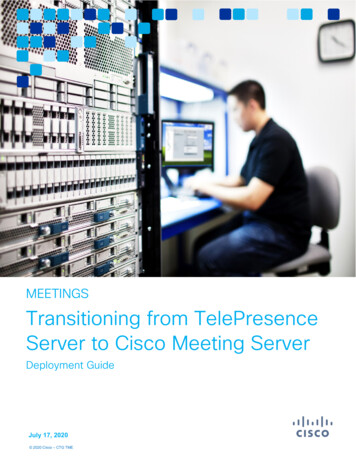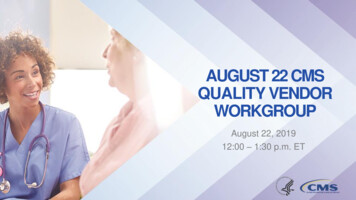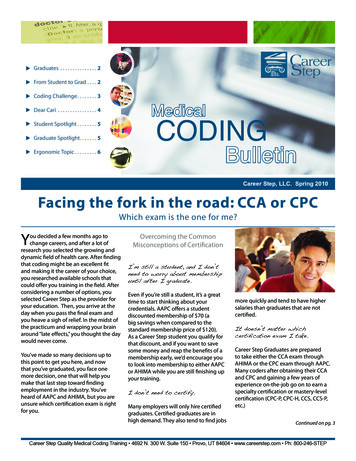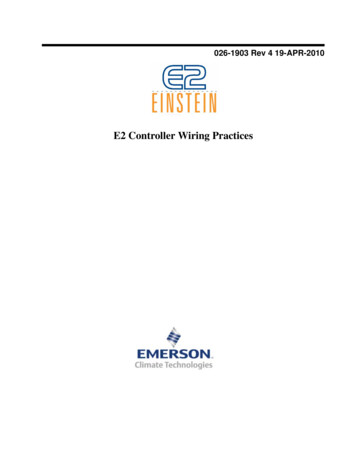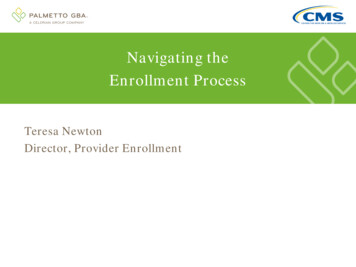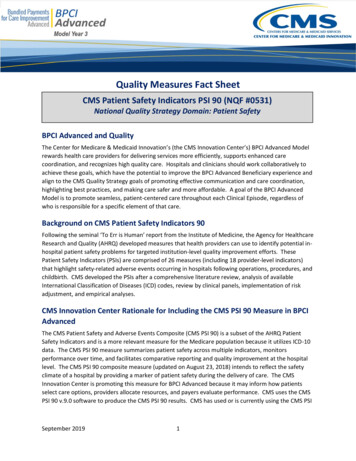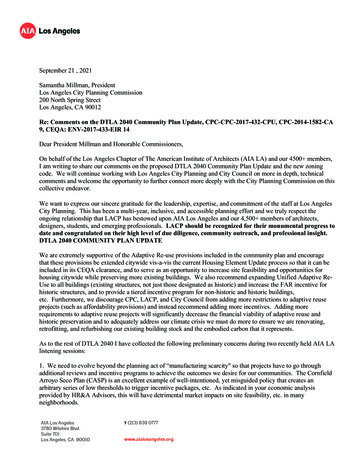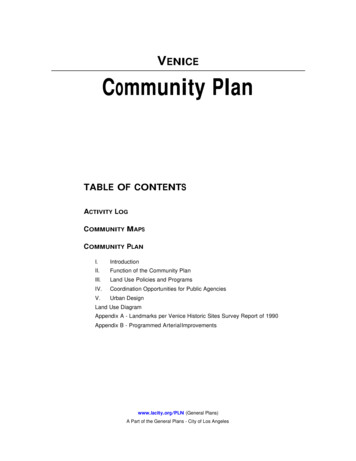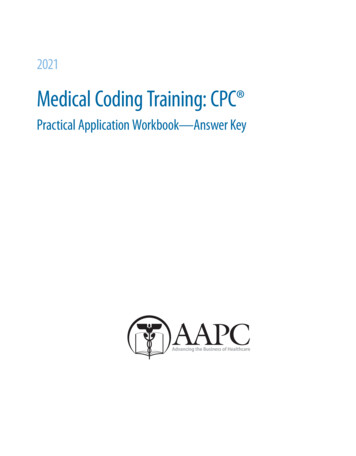
Transcription
Comprehensive Primary Care Plus (CPC )Practice Frequently Asked QuestionsAugust 1, 2016GENERALQ: Why is CMS testing CPC ?CMS believes that through multi-payer payment reform and practice transformation, primary carepractices will be able to build capabilities and care processes to deliver better care, which will result in ahealthier patient population. Payment redesign by payers, both public and private, will offer the ability forgreater cash flow and flexibility for primary care practices to deliver high quality, whole-person, patientcentered care and lower the use of unnecessary services that drive total costs of care.In its first year, CPC achieved gross savings and was nearly cost neutral, with positive quality results.These findings came earlier than expected in a model involving significant changes in the delivery ofprimary care. CPC looks to build on these results by offering two tracks with different payment optionsto better accommodate the diverse needs of primary care practices.Q: When will CPC start and how long will it last? Can I join later?The first performance period for CPC begins on January 1, 2017.CPC consists of five performance years, per the table below. CMS expects practices to participate forthe full five years of the model and, at this time, does not plan to accommodate new practices after 2017.PERFORMANCE YEARS FOR CPC Performance year12345Calendar year20172018201920202021Q: Are practices required to participate in CPC for the full five years?CMS expects practices that participate in CPC will do so for the full five years of the model. However,participation in CPC is voluntary and practices may withdraw from the model without penalty during thefive-year program period. Practices are required to notify CMS at least 90 calendar days before theplanned day of withdrawal. Departing the program before completion of a performance year (PY) puts apractice at risk for recoupment of the prospectively paid performance based incentive payment.Q: Where will CPC be implemented?CPC will be implemented in 14 regions throughout the U.S:1. Arkansas: Statewide2. Colorado: Statewide3. Hawaii: Statewide4. Kansas and Missouri: Greater Kansas City Region5. Michigan: Statewide6. Montana: Statewide7. New Jersey: Statewide
8.9.10.11.12.13.14.New York: North Hudson-Capital RegionOhio: Statewide and Northern Kentucky: Ohio and Northern Kentucky RegionOklahoma: StatewideOregon: StatewidePennsylvania: Greater Philadelphia RegionRhode Island: StatewideTennessee: StatewideThe CPC regions were selected based on payer alignment and market density to ensure that CPC practices have sufficient payer support to make fundamental changes in their primary care delivery.Q: How is CMS defining the “Greater Kansas City (KS & MO)”, “North Hudson-Capital Region (NY)”,“Ohio and Northern Kentucky”, and “Greater Philadelphia (PA)” regions?Based on payer alignment and market density, CMS is defining the regions located in partial states withthe following counties: Kansas and Missouri: Greater Kansas City Region: Johnson County, KS; Wyandotte County, KS;Clay County, MO; Jackson County, MO; Platte County, MONew York: North Hudson-Capital Region: Albany County, NY; Columbia County, NY; DutchessCounty, NY; Greene County, NY; Montgomery County, NY; Orange County, NY; RensselaerCounty, NY; Saratoga County, NY; Schenectady County, NY; Schoharie County, NY; SullivanCounty, NY; Ulster County, NY; Warren County, NY; Washington County, NYOhio: Statewide and Northern Kentucky: Ohio and Northern Kentucky Region: All counties inOhio; Boone County, KY; Campbell County, KY; Grant County, KY; Kenton County, KYPennsylvania: Greater Philadelphia Region: Bucks County, PA; Chester County, PA; DelawareCounty, PA; Montgomery County, PA; Philadelphia County, PA.Only practices located in these counties will be eligible to apply and participate to CPC .Q: Are practices outside of the CPC regions eligible to apply and participate in CPC ?Practices will only be eligible to apply to CPC if they are located in one of the 14 selected CPC regions(see list above). The purpose of the CPC multi-payer design is to ensure that primary care practicesreceive the adequate support from multiple insurers to change care delivery for a practice’s entire panel ofpatients. The CPC regions were carefully selected to ensure adequate payer support for participatingpractices.Q: Which payers have been provisionally selected to partner in CPC ?1. Arkansas: Arkansas BlueCross BlueShield, Arkansas Health & Wellness Solutions, ArkansasMedicaid, Arkansas Superior Select, HealthSCOPE Benefits, QualChoice Health Plan Services,Inc.2. Colorado: Anthem, Colorado Choice Health Plans, Colorado Medicaid, Rocky Mountain HealthPlans, UnitedHealthcare3. Hawaii: Hawaii Medical Service Association4. Kansas and Missouri: Greater Kansas City: BlueCross BlueShield of Kansas City5. Michigan: BlueCross BlueShield of Michigan, Priority Health6. Montana: BlueCross BlueShield of Montana, Montana Medicaid, PacificSource Health Plans7. New Jersey: Amerigroup New Jersey, Inc., Delaware Valley ACO, Horizon BlueCrossBlueShield of New Jersey, UnitedHealthcare8. New York: Hudson Valley Region: Capital District Physicians’ Health Plan, Empire BlueCrossBlueShield, MVP Health Plan, Inc.
9. Ohio and Northern Kentucky: Aetna, Anthem, Aultman Health Foundation, Buckeye Health Plan,CareSource, Gateway Health Plan of Ohio, Inc., Medical Mutual of Ohio, Molina Healthcare ofOhio, Inc., Ohio Medicaid, Paramount Health Care, SummaCare, Inc., The Health Plan,UnitedHealthcare10. Oklahoma: Advantage Medicare Plan, BlueCross BlueShield of Oklahoma, CommunityCareHMO, Inc., Oklahoma Medicaid, UnitedHealthcare11. Oregon: AllCare Health, Inc., ATRIO Health Plans, Inc., CareOregon, Eastern OregonCoordinated Care Organization, FamilyCare Health, Moda Health Plan, Inc., Oregon Medicaid,PacificSource Health, PrimaryHealth of Josephine County, Providence Health Plan, TualityHealth Alliance, Western Oregon Advanced Health, Willamette Valley Community HealthOrganization, Yamhill Community Care Organization, Inc.12. Pennsylvania: Greater Philadelphia: Aetna, Independence BlueCross/Keystone Health Plan East,Delaware Valley ACO13. Rhode Island: BlueCross BlueShield of Rhode Island, Rhode Island Medicaid, Tufts Health Plan,UnitedHealthcare14. Tennessee: Amerigroup Tennessee, Tennessee Medicaid, United Healthcare, Volunteer StateHealth PlanQ: Can practices move from Track 1 to Track 2 throughout the course of the five-year model?No, practices will remain in their respective tracks and may not change tracks throughout the course ofthe five-year model. Practices are invited to apply directly to the track for which they are interested andbelieve they are eligible; however, CMS reserves the right to ask a practice that applied to Track 2 toinstead participate in Track 1 if CMS believes that the practice does not meet the eligibility requirementsfor Track 2 but does meet the requirements for Track 1.Q: Did the Quality Payment Program notice of proposed rule making reference CPC ?CMS announced a proposed rule to implement key provisions of Medicare Access and CHIPReauthorization Act (MACRA) on April 27, 2016. The final rule is anticipated in Fall 2016.The proposed rule includes a list of models that would qualify under the terms of the proposed rule asAdvanced Alternative Payment Models (APMs). CPC is included on the proposed list as an AdvancedAPM and would be subject to medical home model-specific requirements. For 2019 through 2024,clinicians who meet the statutory threshold for sufficient participation in Advanced APMs would beexcluded from the Merit-based Incentive Payment System (MIPS) reporting requirements and paymentadjustments and would qualify for a five percent APM incentive payment.Medical Home Model- Specific Requirements (from page 11-12 of the Quality Payment Programproposed rule fact sheet, which can be found here: MACRA-MIPS-and-APMs/NPRM-QPP-FactSheet.pdf )“Under the statute, medical home models that have been expanded under the Innovation Center authorityqualify as Advanced APMs regardless of whether they meet the financial risk criteria. While medicalhome models have not yet been expanded, the proposed rule lays out criteria for medical home models toensure that primary care physicians have opportunities to participate in Advanced APMs.The rule proposes a definition of medical home models, which focus on primary care and accountabilityfor empaneled patients across the continuum of care. Because medical homes tend to have both lessexperience with financial risk than larger organizations and limited capability to sustain substantiallosses, we propose unique Advanced APM financial risk standards, consistent with the statute, toaccommodate medical homes that are part of organizations with 50 or fewer clinicians.”Additional information is available on the CMS Quality Payment Program website.
Q. What role do other payers play in CPC ?Multi-payer engagement is an essential goal of CPC , as it enables both public and private payers tosponsor comprehensive primary care reform. CMS will partner with payers that share Medicare’s interestin strengthening primary care in each of the 14 regions.Payer partners, both public and private, will provide their own financial support to practices, separatefrom that of Medicare Fee-for-Services (FFS). Any questions regarding non-Medicare payer supportshould be directed to the partnering payer.COMPREHENSIVE PRIMARY CARE INITIATIVE AND CPC Q: What are the major differences between CPC and CPC ?CPC builds upon the lessons learned from the CPC initiative, CMS’ largest investment in primary careto date. Notable changes include:a-CPCCPC Track 1CPC Track 2Size7 Regions; 500practices14 Regions; 2500practices14 Regions; 2500practicesDuration4 y (2012-2016)5 y (2017-2021)5 y (2017-2021)Medicare caremanagement feea 20 PBPM PY1-2; 15PBPM PY3-4; averageacross 4 risk tiers 15 PBPM averageacross 4 risk tiers 28 PBPM averageacross 5 risk tiers; 100for highest-risk tierMedicare payment foroffice visits100% FFS100% FFS100% FFS for nonevaluation andmanagement; reducedFFS up-frontcomprehensive primarycare payment forevaluation andmanagementMedicare incentivepaymentShared savings basedon quality metrics andTotal costs of care(TCOC)b 2.50 PBPMperformance-basedincentive paymentbased on quality andutilization metrics 4 PBPM performancebased incentivepayment based onquality and utilizationmetricsHIT partnersNot requiredNot requiredRequiredPaid only for Medicare FFS beneficiaries attributed to participating practices.bSavings calculated based on any reduction in Medicare Part A and B expenditures.Citation: Sessums LLS, McHugh, SJ, Rajkumar R. Medicare’s vision for advanced primary care: Newdirections for care delivery and payment. JAMA. 2016;315(24):2665-2666.Q: How does CPC impact the prospects of expanding the original CPC initiative?Though CPC ends in December 2016, CMS will continue to consider all available data from CPC as itbecomes available, including shared savings results, quality performance, and the results of the
independent evaluation, to determine whether and/or when to scale the model in accordance with thestatutory requirements for expansion under section 1115A of the Social Security Act.Q: What were practice experiences with the original CPC initiative?Since 2012, the original CPC initiative has built collaborative relationships between payers, primary careclinicians, and other regional stakeholders in each of its seven regions. These relationships took time tobuild. Nonetheless, practice and payer involvement has remained remarkably stable into the fourth year ofCPC. Nearly 90 percent of practices remain in the model at the start of the fourth year, and only a fewsmall payers are no longer involved in CPC or merged with other participating payers since 2012. Manypayers remain engaged in supporting CPC and some have increased their focus on supporting primarycare since CPC began.Additional information regarding practice and payer experience in CPC can be found in the independentevaluation reports conducted by Mathematica Policy Research:o First Annual Reporto Second Annual ReportPAYMENT DESIGNQ: How will primary care practices be paid in CPC ?CPC practices will receive a risk-adjusted, prospective, monthly care management fee (CMF) for theirattributed Medicare fee-for-service patients. Practices will use this enhanced, non-visit-basedcompensation to augment staffing and training in support of population health management and carecoordination. Track 1 practices will receive a CMF that averages 15 per beneficiary per month (PBPM)to support their transformation efforts. Track 2 practices will receive an average of approximately 28PBPM, including a 100 PBPM for a highest risk tier to support the enhanced services beneficiaries withcomplex needs require.CPC Care Management FeesRisk TierAttribution CriteriaTier 11st quartile HCCTier 22nd quartile HCCTier 33rd quartile HCCTier 44th quartile HCC for Track1;75-89% HCC for Track 2ComplexTop 10% HCC(Track 2 only)ORDementiaAverage PBPM-Track 1 6 8 16 30Track 2 9 11 19 33N/A 100 15 28In Track 1, practices will also continue to receive regular Medicare fee-for-service payments for coveredevaluation and management services. In Track 2 of CPC , CMS is introducing a hybrid of fee-for-serviceand Comprehensive Primary Care Payment (CPCP). This hybrid payment will pay for coveredevalulation and management (E&M) services, but allows flexibility for the care to be delivered both inand out of an office visit. Track 2 practices will receive a percentage of their expected Medicare E&Mpayment upfront in the form of a CPCP and a reduced fee-for-service payment for face-to-face E&Mclaims. In an effort to recognize practice diversity in readiness for this change in payment, CMS willallow practices to move to one of these final two proposed hybrid payment options (40 percent or 65percent CPCP with 60 percent or 35 percent FFS), at their preferred pace by 2021, pursuant to the optionsshown in this table:
CPCP and FFS Options201710%/90%CPCP%/FFS%options available 25%/75%to practices, 5%/35%Q: How will primary care practices be encouraged and rewarded for their accountability for patientexperience, clinical quality, and utilization?CMS will prospectively pay a performance-based incentive payment, which practices may keep if theymeet annual performance thresholds. Practices that do not meet the annual thresholds would be requiredto repay all or a portion of the prepaid amount . Practices will thus be “at risk” for the amounts prepaid.The payment will be broken into two distinct components, both paid prospectively: incentives forperformance on clinical quality/patient experience measures and incentives for performance on utilizationmeasures that drive total cost of care. The quality/experience component will be based on performance onelectronic clinical quality measures (eCQM) and Consumer Assessment of Healthcare Providers andSystems (CAHPS) metrics. The utilization component will be based on claims-based measures that arecommonly used to measure total cost of care and measurable at the practice level, such as: inpatientadmissions and emergency department visits that are available in the Healthcare Effectiveness Data andInformation Set (HEDIS).CMS will provide larger performance-based incentive payments in Track 2 than in Track 1, as outlined inthe following table. However, all practices are at risk for repaying all or a portion of the prepaid amountto CMS depending on their performance. The final methodology for calculating the prepaid amounts andrepayment amounts will be outlined in a methodology paper, so practices understand the paymentmechanism prior to the start of the model.CPC Performance Based Incentive PaymentTrackTrack 1Track 2Utilization(PBPM) 1.25 2.00Quality(PBPM) 1.25 2.00Total (PBPM) 2.50 4.00
CPC Frequently Asked QuestionsQ: What are the differences between the three payment elements?1) Care Management Fee (CMF): Both tracks provide a non-visit based CMF paid PBPM. Theamount is risk-adjusted for each practice to account for the intensity of care management servicesrequired for the practice’s specific population. The Medicare FFS CMFs will be paid to thepractice on a quarterly basis.2) Performance-based incentive payment: CPC will prospectively pay and retrospectivelyreconcile a performance-based incentive payment based on how well the practice performs onpatient experience measures, clinical quality measures, and utilization measures that drive totalcost of care.3) Payment under the Medicare Physician Fee Schedule:a. Track 1 continues to bill and receive payment from Medicare FFS as usual.b. Track 2 practices also continue to bill as usual, but the FFS payment for evaluation andmanagement services will be reduced to account for CMS shifting a portion of MedicareFFS payments into Comprehensive Primary Care Payments (CPCP), which will bepaid in a lump sum on a quarterly basis without a claim. Given our expectations thatTrack 2 practices will increase the comprehensiveness of care delivered, the CPCPamounts will be larger than the FFS payment amounts they are intended to replace.CPC Financial Summary TableTrackCare Management Fees,PBPMPerformance-Based IncentivePayments1 15 average2 28 average; 100 forcomplexUtilization and Quality/ExperienceComponentsUtilization and Quality/ExperienceComponentsPayment underMedicare PhysicianFee ScheduleFFS FFS CPCPQ: Will practices be responsible for reporting their Medicare spending to CMS?Yes, CPC practices will be required to both forecast their spending of the care management fee andCPCP and, at the end of the performance year, provide an account of actual CMF and CPCP revenuereceived and actual expenditures. This reporting will help practices understand and optimize their use ofthese alternative payments and will also help CMS to understand how practices use the revenue theyreceive from Medicare to perform the care delivery work the model requires.Q: How will Medicare beneficiaries be attributed to practices?Beneficiaries will be attributed to the practice that either billed for the plurality of their primary careallowed charges, or that billed the most recent claim (if that claim was for Chronic Care Management(CCM) services) during the most recently available 24-month period. If a beneficiary has an equalnumber of qualifying visits to more than one practice, the beneficiary will be attributed to the practicewith the most recent visit. CMS will provide each practice with a list of its prospectively attributedbeneficiaries for each quarter. More details of the Medicare attribution methodology are available inAppendix E of the CPC Request for Applications.Q: How are Medicare FFS beneficiaries assigned to the various risk tiers?CMS assigns beneficiaries to a risk tier based on the individual’s hierarchical condition category (HCC)score. CMS-HCC scores are generated for all Medicare beneficiaries, and are updated annually based onthe beneficiaries’ claims history. CMS will use the most recent HCC scores available in the CMS claimsdatabases at the time of attribution. A beneficiary’s HCC score will determine to which risk quartile the
CPC Practice Frequently Asked Questionsbeneficiary will be assigned (see CPC Care Management Fees table), based on comparison to thepopulation of Medicare FFS beneficiaries in that region. In Track 2, the complex tier will be based on acombination of HCC score and beneficiaries who have a diagnosis of dementia.Q: What kind of patients will be included in the “complex tier” of top 10 percent HCC for theCPC care management fee?The top 10 percent of the HCC risk pool will represent patients who are the “sickest of the sick,” withmultiple conditions and high expected costs. The exact range of HCC scores and number of beneficiariesassigned to the complex tier will vary based on region, due to different populations and variations incoding practices. For a more detailed description of the HCC methodology, as well as detailedinformation on what diagnoses are included in the HCC scores, please refer to this independent evaluationreport.In addition to beneficiaries in the top 10 percent HCC, beneficiaries who have a diagnosis of dementiawill also be assigned to the complex tier. Dementia diagnosis is assigned based on a chronic conditionflag generated annually based on a set of diagnoses codes present in the prior three years. For detailedinformation, please refer to the Chronic Conditions Warehouse.CARE DELIVERY DESIGNQ: What are the main design features of the CPC care delivery model?In CPC , practices will be guided by Comprehensive Primary Care Functions: (1) Access and Continuity;(2) Care Management; (3) Comprehensiveness and Coordination; (4) Patient and Caregiver Engagement;and (5) Planned Care and Population Health. In Track 2, the practices will heighten their focus on caringfor patients with complex medical, behavioral, and psychosocial needs. Thus, Track 2 practices willincrease the breadth and depth of services offered, as well as inventory resources and supports necessaryto meet their psychosocial needs, as appropriate. Because comprehensive primary care requires advancedhealth information technology (health IT) support for its population-health focus and team-basedstructure, CMS will require Track 2 practices to engage directly with vendors about model goals andrequirements.Q: What does it mean that practices will enhance the comprehensiveness of care in the primary caresetting?Comprehensiveness in the primary care setting refers to the practice meeting the majority of its patientpopulation’s medical, behavioral, and psychosocial needs. Strategies to achieve comprehensivenessinvolve the use of analytics to identify needs at a population level and developing processes to meet thoseneeds. This includes building capability within the practice, as well as building strong and coordinatedreferral networks within the medical neighborhood and with community-based services.Comprehensiveness adds both breadth and depth to the delivery of primary care services; builds on thepatient-practitioner relationship that is at the heart of effective primary care; and is associated with lessfragmented care, better health outcomes, and lower overall costs.Q: What changes will practices be expected to make in their care delivery in the first performance year(PY 2017)?The CPC care delivery requirements are intended to provide a framework for practices to deepen theircapabilities throughout the five-year model. These incremental requirements will guide practices throughthe five comprehensive primary care functions and will serve as markers for regular, measureableprogress to the CPC model aims. Track 2 care delivery requirements are inclusive of and build upon theTrack 1 requirements, as the framework for delivering better care, smarter spending, and healthier peoplein CPC is the same across both tracks. Track 2 includes additional requirements that will assist practices
CPC Practice Frequently Asked Questionsto increase the depth, breadth, and scope of care offered, with particular focus on their patients withcomplex needs.For a detailed description, please refer to the 2017 CPC practice care delivery requirements.Q: What learning and technical assistance supports will CPC offer to participating practices?CPC will offer participating practices a variety of learning opportunities to support their transformationneeds with in-person, virtual, and on-demand events and information. National and regional learningcommunities will provide CPC practices with opportunities for in-person and web-based learning.Learning events and materials will orient practices to CPC program requirements and guide practicesthrough the CPC corridors of work. Online collaboration tools and web-based portals will facilitatepractice sharing. Regional learning communities will also offer targeted, practice-level technicalassistance to support practices to enhance their capabilities.QUALITY MEASUREMENTQ: How will CPC measure the improvement in the quality of care for and experience of care bypatients?This model aims to improve the quality and experience of care that beneficiaries receive and decrease thetotal cost of care. To assess quality performance and eligibility for the CPC performance-based incentivepayment, CMS will require Track 1 and 2 practices to annually report electronic clinical quality measures(eCQMs) and patient experience of care measures (Consumer Assessment of Healthcare Providers &Systems [CAHPS]). eCQMs must be reported at the practice-site level and are specified to include allpractice population patients, regardless of payer or insurance status. CAHPS surveys will be administeredby CMS or its contractors to patients in practices in Track 1 and Track 2. In future years, Track 2practices may also use a patient reported outcome measure survey.The provisional Quality and Utilization Measure Set for CPC is available in Appendix D of the Requestfor Applications. The quality reporting requirements may undergo changes prior to the start of CPC ,after the final list of the MIPS measures are published in the Quality Payment Program final rule.Q: How does a multi-specialty practice complete practice-site quality reporting?CPC practitioners may share physical space and an electronic health record (EHR) with otherpractitioners who do not participate in CPC . By 2018, all CPC practice sites must have functionality tofilter electronic clinical quality measure (eCQM) data by the practice site location as well as TaxpayerIdentification Number/National Provider Identifier (TIN/NPI). This filtering functionality (C4certification) will allow practices to include in the measure calculation only patients seen by CPC practitioners. The CPC practice site level reporting requirement means that any patient who is seen atleast one time at the practice during the calendar year by a CPC practitioner is eligible to be included inthe denominator of a measure. If a patient was only seen by a non-CPC practitioner at the practice, thepatient will not be included in the denominator of the measure.HEALTH IT REQUIREMENTSQ: What are the technology requirements for Track 1 and 2 practices?Practices in both Tracks 1 and 2 are required to adopt the following health IT to participate in CPC : Practices should adopt the certified health IT modules that meet the definition of CEHRTaccording to the timeline and requirements finalized for use in CMS programs supporting
CPC Practice Frequently Asked Questionscertified EHR use (e.g., EHR Incentive Programs. Consistent with these programs, practices canuse either 2015 Edition or 2014 Edition technology in 2017, but must use only 2015 Editiontechnology starting in 2018.Practices in both Tracks 1 and 2 also need to meet certain technology requirements in order to report onrequired electronic clinical quality measures (eCQMs) under the program: Practices will need to adopt health IT certified to the (c)(1) – (c)(3) certification criteria for all ofthe electronic clinical quality measures in the CPC measure set. As with the overall CEHRTrequirements, practices should follow the requirements and timeline of the EHR IncentiveProgram (i.e., practices can use either 2015 Edition or 2014 Edition technology in 2017, but mustuse only 2015 Edition technology starting in 2018).For the CPC measures, practices must use the latest annual measure update. For instance, for the2017 performance period, practices must use the eCQM specifications contained in the 2016annual update, released in April 2016 lation/ehrincentiveprograms/ecqm library.html).Finally, practices must be able to filter their electronic clinical quality measure data by practicesite location and TIN/NPI beginning in 2017. Beginning in 2018, practices will demonstrate theirability to conduct this filtering by adopting 2105 Edition health IT certified to the criterion foundat 45 CFR 170.315(c)(4).To support specific Track 2 enhanced health IT functions, Track 2 practices will also be expected to meettwo additional certified technology requirements: Adopt health IT certified to the 2015 Edition “Care Plan” criterion found at 45 CFR170.315(b)(9) by January 1, 2019 (the beginning of performance year (PY) 3 of CPC ).Adopt health IT certified to the 2015 Edition “Social, Behavioral, and Psychosocial Data”criterion found at 45 CFR 170.315(a)(15) by January 1, 2019 (the beginning of performance year3 of CPC ).Q: Can practices apply for Track 2 even if their vendor is not included on the CPC Vendor List?Yes, the Vendor List is purely voluntary and provided for informational purposes. Practices may indicatesupport from a vendor regardless of whether they are on the informational list.Vendors may submit information about their health IT product and contact information to be included inthe CPC Vendor List. Vendors should email CPCPlus@CMS.HHS.gov with a brief paragraph abouttheir health IT product, the CPC Track 2 advanced health IT functions they support, and their contactinformation for interested practices.Vendors with products that support one or more of the advance health IT functions for Track 2 may alsosubmit a global vendor letter of support to CPCPlus@CMS.HHS.gov. CMS is providing the letters ofsupport for the convenience of the CPC practices. The letter of support is designed to let CMS know thatan applicant practice has a plan for meeting the requirements of the model. Please note that the vendor’sbusiness relationship with a practice is s
Coordinated Care Organization, FamilyCare Health, Moda Health Plan, Inc., Oregon Medicaid, PacificSource Health, PrimaryHealth of Josephine County, Providence Health Plan, Tuality Health Alliance, Western Oregon Advanced Health, Willamette Valley Community Health Organization, Yamhill Community Care Organization, Inc. 12. Pennsylvania: Greater .

